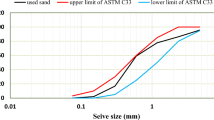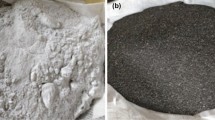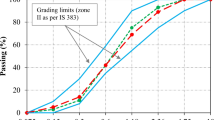Abstract
Self-compacting concrete (SCC) is one of the emerging materials and because of its better fresh and hardened properties, its application is increasing day by day in the construction industry. Utilizing lightweight aggregates and fibers could improve further fresh and hardened properties of SCC. But due to considerable differences between the densities of lightweight, aggregates and binders will result in poor fresh and hardened properties. In this research work, expanded polystyrene beads utilized as coarse aggregate and inclusion of different percentage of waste plastic fiber (WPF) has been used to find the effect on fresh and hardened properties of SCLWC through experiments. The results reveal better fresh properties of SCLWC; however, the optimum fresh properties achieved at E1.0 mixture. Also, the compressive and flexural strengths increased with increasing the percentage of WPF in SCLWC. Moreover, ultrasonic pulse velocity decreased with increasing WPF in SCLWC. The wet density, dry density and percent absorption showed a mixed trend of increasing and decreasing with increasing percentage of WPF; however, all these values were within the ENFARC limits for SCC. And SEM images showed the number of voids on the surface of produced SCLWC specimens.






















Similar content being viewed by others
References
Topcu, I.B.: Physical and mechanical properties of concretes produced with waste concrete. Cem. Concr. Res. 27, 1817–1823 (1997)
Vivian, W.Y.; Tam, C.M.: Evaluations of existing waste recycling methods: a Hong Kong study. Build. Environ. 41, 1649–1660 (2006)
Kan, A.; Demirboga, R.: A new technique of processing for waste-expanded polystyrene foams as aggregates. J. Mater. Process. Technol. 209, 2994–3000 (2009)
Ismail, Z.Z.; AL-Hashmi., E.A.: Use of waste plastic in concrete mixture as aggregate replacement. Waste Manag. 28, 2041–2047 (2008)
Al-Salem, S.M.; Lettieri, P.; Baeyens, J.: Recycling and recovery routes of plastic solid waste (PSW): a review. Waste Manag. 29, 2625–2643 (2009)
Guerrero, L.A.; Maas, G.; Hogland, W.: Solid waste management challenges for cities in developing countries. Waste Manag. 33, 220–232 (2013)
Iucolano, F.; Liguori, B.; Caputo, D.; Colangelo, F.; Cioffi, R.: Recycled plastic aggregate in composition: effect on physical and mechanical properties. Mater. Des. 52, 916–922 (2013)
Guiqing, W.; Li, J.; Zhenming, X.: Triboelectrostatic separation for granular plastic waste recycling: a review. Waste Manag. J. 33, 585–597 (2013)
Liguori, B.; Iucolano, F.; Lavorgna, M.; Verdolotti, L.: The effect of recycled plastic aggregate on chemico-physical and functional properties of composite mortars. Mater. Des. J. 57, 578–584 (2014)
Ghernouti, Y.; Rabehi, B.; Bouziani, T.; Ghezraoui, H.; Makhloufi, A.: Fresh and hardened properties of self-compacting concrete containing plastic bag waste fibers (WFSCC). Constr. Build. Mater. 82, 89–100 (2015)
Al-Hadithi, A.I.; Hilal, N.N.: The possibility of enhancing some properties of self-compacting concrete by adding waste plastic fibers. J. Build. Eng. 8, 20–28 (2016)
ACI Committee: Guide for Structural Lightweight Aggregate Concrete [R]. 213 R-0.3. American Concrete Institute, Farmington Hills (2003)
Narayanan, N.; Ramamurthy, K.: Structure and properties of aerated concrete: a review. Cem. Concr. Compos. 22(5), 321–329 (2000)
Jones, M.R.; Mccarthy, A.: Preliminary views on the potential of foamed concrete as a structure material. Mag. Concr. Res. 57(1), 21–31 (2005)
Wee, T.H.; Babu, D.S.; Tamilselvan, T.; et al.: Air-void system of foamed concrete and its effect on mechanical properties. ACI Mater. J. 106(1), 45–52 (2006)
Babu, D.S.; Babu, K.G.; Wee, T.H.: Effect of polystyrene aggregate size on the strength and moisture migration characteristics of lightweight concrete. Cem. Concr. Compos. 28(6), 520–527 (2006)
Cook, D.J.: Expanded polystyrene concrete. In: Swamy, N. (ed.) Concrete Technology and Design: New Concrete Materials, pp. 41–69. Survey University Press, London (1983)
Cook, D.J.: Expanded polystyrene beads as lightweight aggregate for concrete. Precast Concr. 4, 691–693 (1973)
Babu, K.G.; Babu, D.S.: Behaviour of lightweight expanded polystyrene concrete containing silica fume. Cem. Concr. Res. 33(8), 755–762 (2003)
Babu, D.S.; Babu, K.G.; Wee, T.H.: Properties of lightweight expanded polystyrene aggregate concretes containing fly ash. Cem. Concr. Res. 35(12), 1218–1223 (2005)
Chen, B.; Liu, J.: Properties of lightweight expanded polystyrene concrete reinforced with steel fiber. Cem. Concr. Res. 34(12), 1259–1263 (2004)
Chen, B.; Liu, J.: Mechanical properties of polymer modified concretes containing expanded polystyrene beads. Constr. Build. Mater. 21(1), 7–11 (2005)
Miled, K.; Le Roy, R.; Sab, K.; et al.: Compressive behavior of an idealized EPS lightweight concrete: size effects and failure mode. Mech. Mater. 36(10), 1031–1046 (2004)
Le Roy, R.; Parant, E.; Boulay, C.: Taking into accounts the inclusions’ size in lightweight concrete compressive strength prediction. Cem. Concr. Res. 35(5), 770–775 (2005)
Bouvard, D.; Chaix, J.M.; Dendievel, R.; et al.: Characterization and simulation of microstructure and properties of EPS lightweight concrete. Cem. Concr. Res. 37(12), 1666–1673 (2007)
Miled, K.; Sab, K.; Le Roy, R.: Particle size effect on EPS lightweight concrete compressive strength: experimental investigation and modeling. Mech. Mater. 39(2), 222–240 (2007)
Bagon, C.; Frondistou, Y.S.: Marine floating concrete made with polystyrene beads. Mag. Concr. Res. 28(2), 225–229 (1976)
Perry, S.H.; Bischoff, P.H.; Yamura, K.: Mix details and material behaviour of polystyrene aggregate concrete. Mag. Concr. Res. 43(1), 71–76 (1991)
Ravindrarajah, R.S.; Tuck, A.J.: Properties of hardened concrete containing treated expanded polystyrene beads. Cem. Concr. Compos. 16(3), 273–277 (1994)
Grunewald, S.; Walraven, J.C.: Parameter-study on the influence of steel fibers and coarse aggregate content on the fresh properties of self-compacting concrete. Cem. Concr. Res. 31(11), 1793–1798 (2001)
Bing, C.; Jie, L.; Long-zhu, C.: Experimental study of lightweight expanded polystyrene aggregate concrete containing silica fume and polypropylene fibers. J. Shanghai Jiaotong Univ. (Sci.) 15(2), 129–137 (2010)
EFNARC (European Federation of Specialist Construction Chemicals and Concrete Systems): The European guidelines for self-compacting concrete: Specification, production and use. http://www.efnarc.org/pdf/SCCGuidelinesMay2005.pdf (2005). Accessed 29 Jan 2020
Kivrak, S.; Tuncan, M.; Onur, M.I.; Arslan, G.; Arioz, O.: An economic perspective of advantages of using lightweight concrete in construction. In: Proceedings of 31st Conference on Our World in Concrete and Structures. CI-Premier, Singapore (2006)
Abdelaziz, G.E.: A study on the performance of lightweight selfconsolidated concrete. Mag. Concr. Res. 62(1), 39–49 (2010)
Bogas, J.A.; Gomes, A.; Pereira, M.F.C.: Self-compacting lightweight concrete produced with expanded clay aggregate. Constr. Build. Mater. 35, 1013–1022 (2012)
Andiç-çakır, Ö.; Yoğurtcu, E.; Yazıcı, Ş.; Ramyar, K.: Selfcompacting lightweight aggregate concrete: design and experimental study. Mag. Concr. Res. 61(7), 519–527 (2009)
Collepardi, M.: Chemical admixtures today. In: Proceedings of second international symposium on concrete technology for sustainable February—development with Emphasis on Infrastructure, Hyderabad, India, 27 February–3 March, pp. 527–541 (2005)
Khayat, K.H.; Bickley, J.; Lessard, M.: Performance of self-consolidating concrete for casting basement and foundation walls. ACI Mater. J. 97, 374–380 (2000)
ASTM C 642: Density Absorption and Voids in Hardened Concrete. American Society for Testing and Materials, West Conshohocken (2006)
ASTM C39, C39M-12: Standard Test Method for Compressive Strength of Cylindrical Concrete Specimens, vol. 04–02, p. 7. Annual Book of ASTM Standard, Philadelphia (2012)
ASTM C78-84: Standard Test Method For Flexural Strength of (Using Simple Beam With Third-Point Loading), vol. 04–02, pp. 32–34. Annual Book of ASTM Standard, Philadelphia (1989)
Tomaz, P.; Jacek, K.: Properties of fresh SCC mix reinforced by different types of steel and polymer fiber. Constr. Build. Mater. 62, 96–101 (2014)
Barros, J.; Pereira, E.; Santos, S.: Lightweight panels of steel fiber-reinforced self-compacting concrete. J. Mater. Civil Eng. 19(4), 295–304 (2007)
Yang, S.; Yue, X.; Liu, X.; Tong, Y.: Properties of self-compacting lightweight concrete containing recycled plastic particles. Constr. Build. Mater. 84, 444–453 (2015)
Ovbeniyekede, O.S.; Adenan, D.S.Q.A.; Ahmad, M.; Kamaruddin, K.: Water absorption and compressive strength of self compacting concrete incorporating fly ash and quarry dust. Int. J. Sci. Res. Publ 8(10), 377–384 (2018)
Barroqueiro, T.; da Silva, P.R.; de Brito, J.: Fresh-state and mechanical properties of high-performance self-compacting concrete with recycled aggregates from the precast industry. Materials 12, 3565 (2019)
Salman, G.A.: Density and ultrasonic pulse velocity investigation of self-compacting carbon fiber-reinforced concrete. Eng. Technol. J. 36(1), 89–99 (2018)
Jones, R.; Gatfield, E.: Testing concrete by an ultrasonic pulse technique. DSIR Road Research Technical Paper No. 34 (London, H. M. S. O) (1955)
Author information
Authors and Affiliations
Corresponding author
Ethics declarations
Conflict of interest
The authors have no conflict of interest by any means.
Rights and permissions
About this article
Cite this article
Medher, A.H., Al-Hadithi, A.I. & Hilal, N. The Possibility of Producing Self-Compacting Lightweight Concrete by Using Expanded Polystyrene Beads as Coarse Aggregate. Arab J Sci Eng 46, 4253–4270 (2021). https://doi.org/10.1007/s13369-020-04886-9
Received:
Accepted:
Published:
Issue Date:
DOI: https://doi.org/10.1007/s13369-020-04886-9




